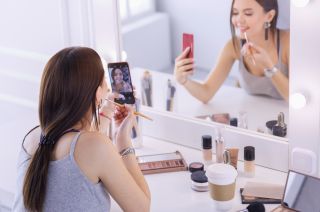
In recent years, TikTok has transformed how we share stories and connect with others, often serving as a space for creativity and emotional expression. Makeup and skincare tutorials, once solely about beauty techniques, have evolved into platforms where creators reflect on deeply personal and sometimes troubling experiences. The act of sharing such stories within the structure of a self-care routine can be surprisingly therapeutic, supported by psychological research. From the soothing power of rituals to the reflective nature of mirrors, there are clear psychological factors that explain the appeal and effectiveness of this medium for processing personal challenges.
Here are some research-backed reasons why skincare and makeup tutorials provide a unique framework for emotional healing. We also consider the importance of self-awareness and discernment in sharing personal experiences.
The Psychological Benefits of Rituals
Rituals, such as applying makeup or completing a skincare routine, have been shown to reduce stress and promote emotional stability. Ritualistic behaviors provide structure and predictability, which can soothe the mind during chaotic or emotionally turbulent times. Norton and Gino (2014) found that rituals help reduce anxiety and improve emotional regulation by fostering a sense of control.
When individuals engage in skincare or makeup routines, these activities’ repetitive and mindful nature can serve as a grounding technique. These routines help anchor individuals in the present moment, allowing them to process difficult emotions without becoming overwhelmed. This aligns with findings from research on mindfulness, which suggests that repetitive, focused activities can calm the brain and lower stress responses (Tang et al., 2015).
The Role of Touch and Oxytocin Release
The tactile element of skincare and makeup application is crucial in promoting emotional well-being. Research shows that gentle touch can stimulate the release of oxytocin, a hormone associated with feelings of bonding, relaxation, and stress reduction (Field, 2014).
While skincare routines are not equivalent to professional massage therapy, the soothing motions of applying serums or massaging moisturizers mimic similar calming effects. These actions help decrease cortisol, the body’s primary stress hormone, and increase serotonin and dopamine—neurotransmitters that regulate mood and emotional stability (Field, 2014). By combining these tactile rituals with storytelling, creators may experience physical relaxation and emotional catharsis.
The Reflective Power of Mirrors
The mirror, a central feature in skincare and makeup routines, offers more than a view of one’s physical appearance—it provides a space for emotional self-reflection. My book, Mirror Meditation: The Power of Neuroscience and Self-Reflection to Overcome Self-Criticism, Gain Confidence, and See Yourself with Compassion, explores how mirrors can be used to foster mindfulness and self-awareness. Looking into the mirror mindfully during a skincare routine allows individuals to confront their vulnerabilities and emotions in a supportive and nonjudgmental way. Engaging in self-focused practices—like mirror meditation—can reduce self-criticism and promote emotional resilience. For creators on TikTok, the mirror becomes a metaphorical canvas where they not only transform their physical appearance but also reflect on their inner experiences.
Narrative Processing Through Dual Engagement
Combining verbal storytelling with the nonverbal activity of makeup or skincare application creates a dual engagement that can facilitate emotional regulation. Research on expressive writing and creative expression supports this concept, which found that engaging in creative tasks while processing emotions helps individuals articulate their feelings more effectively and reduces the intensity of negative emotions (Fancourt et al., 2019).
Makeup and skincare routines provide a similar outlet. The physical act of self-care offers a calming distraction, which may allow people to process their experiences at a manageable pace. Meanwhile, narrating their stories gives them a sense of agency and coherence over their emotions, which is a critical component of psychological recovery (Pennebaker & Seagal, 1999)
Community and Social Validation
TikTok provides a platform where creators can share their struggles with an audience that often responds with empathy and support. Research indicates that sharing personal experiences online can reduce isolation and foster a sense of belonging (Utz & Breuer, 2017). For individuals processing troubling experiences, receiving validation and understanding from others can be a powerful motivator for emotional healing.
This sense of community is especially for young people, who may feel more comfortable expressing their emotions in digital spaces. By framing their stories within the structure of a makeup or skincare tutorial, creators can share their vulnerabilities in a way that feels approachable and relatable to their audience.
The Risks of Oversharing
While there are clear benefits to using TikTok tutorials as a space for emotional expression, it’s important to consider the potential risks of oversharing. In a recent post, I discussed key reasons for discernment about who we share our vulnerabilities as an act of self-care and self-respect. Not everyone is entitled to witness our most personal moments, and oversharing on social media can sometimes lead to negative outcomes, such as regret, misinterpretation, or emotional harm. Oversharing can backfire when you do not receive the expected level of empathy or support, potentially exacerbating feelings of isolation or rejection. Practicing self-awareness and setting boundaries around what and how much to share are critical for protecting one’s emotional well-being.
By choosing to share mindfully and within safe boundaries, creators can harness the therapeutic potential of these routines while safeguarding their emotional well-being. In this way, makeup and skincare tutorials transcend their original purpose, becoming tools for self-reflection, connection, and emotional growth.
Copyright 2024 Tara Well, Ph.D.
